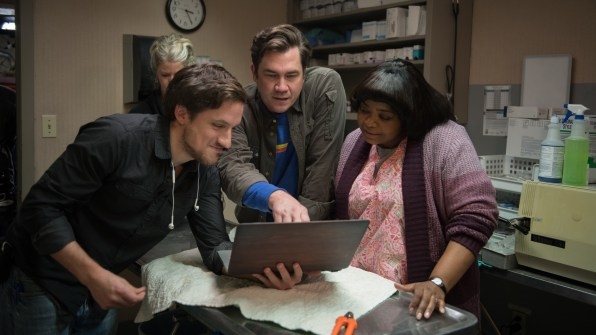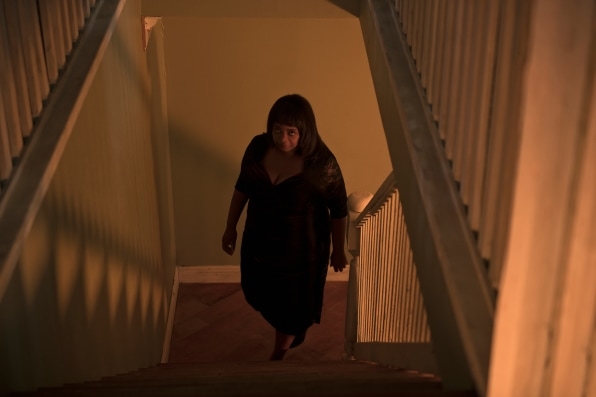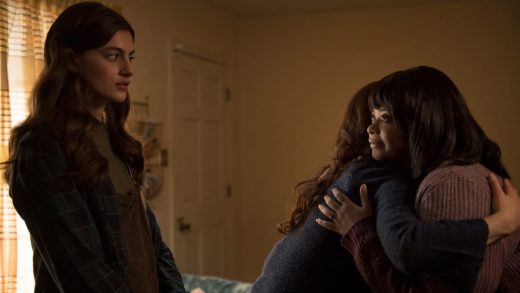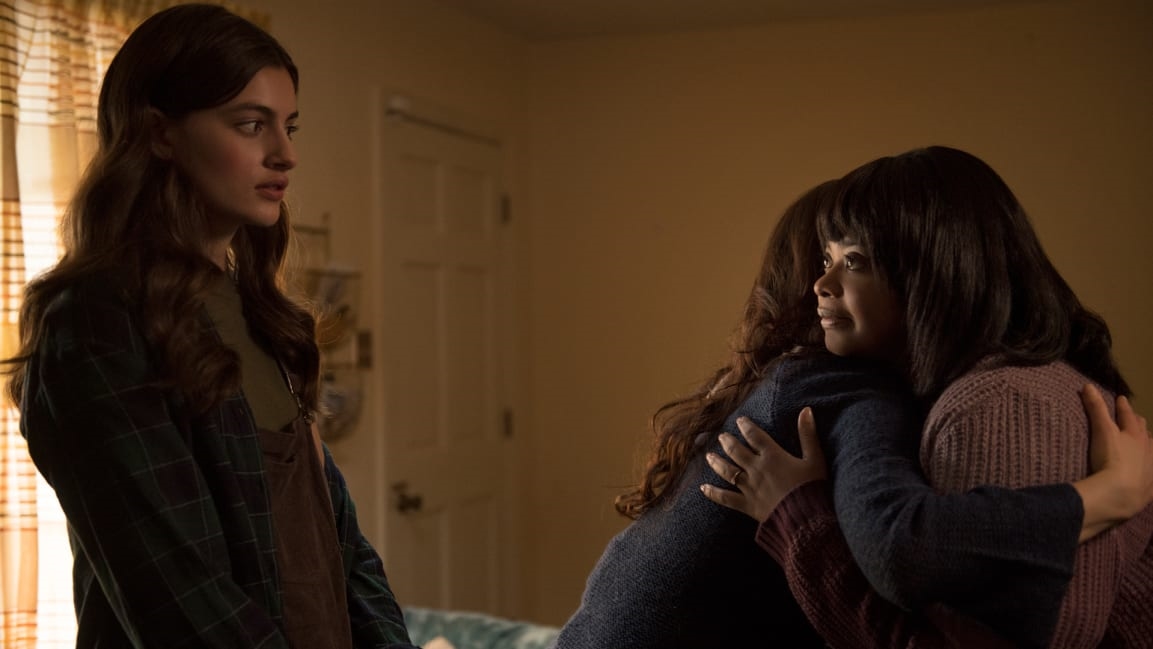How Ma director Tate Taylor helped Octavia Spencer unleash her inner sociopath
When Workaholics writer Scotty Landes’s script about a middle-age woman who befriends, terrorizes, and tortures unsuspecting teenagers was optioned by Blumhouse, director Tate Taylor signed onto the project right away, and he knew exactly who would be perfect for the lead role.
Just a month prior, a frustrated Octavia Spencer called Taylor saying she was tired of being typecast as “the magical negro.” The two worked together on The Help (for which she won an Oscar) and have been close friends for nearly 25 years, so Taylor knew what Spencer is capable of–not to mention how twisted she really is.
“Octavia loves fucked-up shit,” Taylor says. “Her idea of relaxation when she’s off of a job, she likes to go home, get in her bed for three days, and watch murder TV, all of the forensic shows. She could open a museum or do talks. She knows everything about serial killers.”
So when Ma fell into Taylor’s hands, Spencer leapt at the chance to break away from the sassy sidekick and dive into her first lead role that’s by far the darkest she’s tackled. “She was so excited to be beaten and hit and fuck up people,” Taylor says. “It was like summer camp for her.”
Ma stars Spencer as Sue Ann, a kindly veterinarian assistant who befriends a group of high schoolers after she agrees to buy them booze and let them turn her basement into their own hangout spot. Sue Ann soon finds herself in with the in-crowd and is affectionately called “Ma.” But her true motives start to surface along with repressed childhood trauma.
Like other classic female antiheroes, including Annie Wilkes in Misery and Alex Forrest in Fatal Attraction, Taylor wants audiences to straddle the line between cheering for Sue Ann’s revenge and rooting for her comeuppance. To do that, Taylor explains how he a created a relatable backstory, then drove everything straight to a figurative hell replete with a raging fire, maimed children, and a stomach-turning blood transfusion–all on the way to an oddly satisfying ending.
WARNING: SPOILERS AHEAD!
Creating Carrie 2.0
“When the script came to me, it was written for a middle-aged white woman and there was no backstory–she was just a sociopath,” Taylor says. “I reshaped the script for Octavia, and I just knew that we needed to create a backstory that basically could be ripped from the headlines of today to talk about trauma and how it can damage someone for the rest of their life.”
There are intermittent flashbacks throughout Ma that show Sue Ann in high school (played by Kyanna Simone Simpson) in the same town as present-day. She’s geeky. She’s awkward. And she’s madly in love with the most popular guy in school, Ben (Andrew Matthew Welch). It seems as if he’s into her too when he invites her to the janitor’s closet to fool around. But it’s all a sick prank. Sue Ann is tricked into performing a sexual act on someone who wasn’t Ben. When she steps out of the closet, the whole school is there, laughing in her face.
Three decades later, as fate would have it, one of the teenagers in the group that convinces Sue Ann to buy them alcohol is Ben’s son. When Sue Ann makes that connection, her plot for revenge begins to take shape.
“You can look at it as a cautionary tale: Be careful who you bully. We felt like the movie tagline should be, ‘Revenge is a bitch.’ Universal wasn’t going for that, but we thought it was perfect,” Taylor says.
Having a backstory like that, Taylor says, “leaves you weirdly protective of your villain. I never felt that way about Kathy Bates’s character [in Misery]. I was just scared. I felt that way a little bit with Carrie. I was like, ‘Give her a fucking break.’ And in many ways, Ma is what would have happened if Carrie had waited 30 years to get them back. You were just a sleeping monster until that scab was picked again.”

[Photo: Anna Kooris/Universal Pictures]
Ma’s Alamo
Sue Ann’s behavior becomes increasingly erratic (incessant texting, angry outbursts, stealing the girls’ jewelry), but she becomes completely unhinged after Ben finds out she’s been hanging around his son and orders her to stay away. After that, Sue Ann unleashes holy hell, mowing someone down with her car, injecting someone else with dog’s blood (yes, really), chaining people up in her basement, and painting the token black kid white. In the end, as the cops close in, she has to make a decision whether to live or die.
“The way I work is, I look at each day as a short film: How do I make this day of filming the best it can be as if this is the only thing we are doing?” Taylor says. “And it just kinda came to me that this love that she was so confused by goes back to: Look what you do to people when they’re traumatized and you abuse them.”
“The horrible night and morning in the basement–that’s Ma’s Alamo,” Taylor says.

[Photo: Anna Kooris/Universal Pictures]
Bring on more “great, weird shit”
“This is an odd film,” Taylor admits. “It doesn’t fit into an exact genre. It’s all over the place in the best way.”
Taylor has dabbled in the thriller space before, with 2016’s The Girl on the Train, which he directed and would have pushed into even darker directions if he’d been able. Since Ma falls more into the horror genre, he says, he felt freer.
Blumhouse, which produced Ma, specializes in the horror category, no matter how odd the script. Horror films are famously inexpensive to make, and Blumhouse has perfected the model of exchanging a relatively low budget for total creative control.
“With Blumhouse, you’re able to go for it. It may work great or if it doesn’t work, no harm, no foul. You tried and it wasn’t that expensive,” Taylor says. “So when you have that freedom, it opens up creatively in your mind. You’re almost like a little kid who drank a liter of Coke–you’re bouncing off the walls. You’re challenging yourself to come up with something risky because you can–and it’s applauded if you do. And when you do that, you have pull from various inspirations that don’t necessarily make sense combined with the others.”
That blending of genres is where Taylor feels some of the most exciting storytelling can come from. It would be a stretch to call Ma a horror comedy, but there are certainly elements of the film that revel in the absurd.
“I think all genres can be hybrid. The trick is, audiences tend to resist it because they don’t want things to be hard. They don’t want to learn a new way to watch a movie,” Taylor says. “I think that we’re ready to reward filmmakers and television producers for giving us something a little different and off-kilter. Look at shows like Barry. There’s great, weird shit out there finally.”
Fast Company , Read Full Story
(79)



